Want to learn about Premier's fencing for vineyards?
Read Premier's Farm Diary
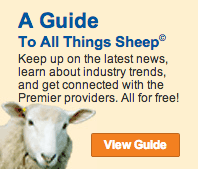
NETTING FOR GRAZING SHEEP
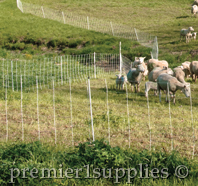
Grazing sheep with ElectroNet® 9/35/12. Netting easily adapts to hills and curves. For multiple hills and curves, ElectroNet® Plus with added support posts is a good choice.
ElectroNet® 9/35/12
| • |
9 horizontal strands
|
| • |
35" tall
|
| • |
Vertical struts every 12"
|
| • |
Posts (built-in) every 12.5 ft, .50" diameter
|
| • |
Post spikes (SS or DS): .26" diameter, 6" long
|
ElectroNet arrives at your door as a complete fence with line posts already built into each roll.
When installed and energized properly, it’s a nearly impenetrable mesh to sheep, goats, coyotes and dogs. Contrasting black and white colors provide 24/7 visibility to animals against all backgrounds.
The prefabricated net has 9 horizontal twines (8 are conductive) and white plastic vertical struts every 12". White PVC posts are pre-installed into the mesh every 12.5 ft. (Also available with double spiked posts for added stability.) Its very low electrical resistance (38 ohms/1000 ft) is important for fences that are either long or will experience high weed contact.
The Pos/Neg version is recommended for dry (grass turns brown for 4 weeks or longer) or snow-covered sites. To install, just unfold it and set the posts (by hand or foot).
ElectroNet® Plus 9/35/12
To help with sagging, this netting has extra posts to shorten the distance between posts (6.8 ft compared to 12.5 ft). Extra posts make the netting heavier so we shortened the length to make the fence more manageable.
PREMIER ENERGIZERS
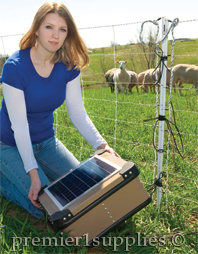
ElectroNet® and PRS solar energizers are an excellent combination for portable fences. For fencing in the fall, make sure the energizer faces due south to maximize exposure to sunlight.
PRS Solar Energizers
Which unit is right for you?
The size, in pulse energy output (range from .5 joule to 2 joules), depends almost entirely on the weed contact that will occur and the length of the fence.
Contact Premier or call 800-282-6631 to speak with one of our fence consultants to help you determine the best energizer for your needs.
You can also view our energizer comparison charts online or in Premier's fencing catalog to help in choosing an energizer.
View our how-to PRS videos:
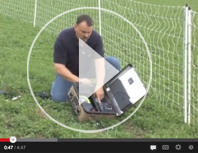 "How to get your PRS solar energizer ready for fencing season"
"How to get your PRS solar energizer ready for fencing season"
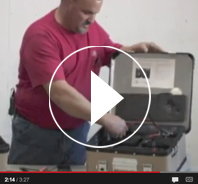 "Properly storing energizers and batteries for winter"
"Properly storing energizers and batteries for winter"
|
 |
 |
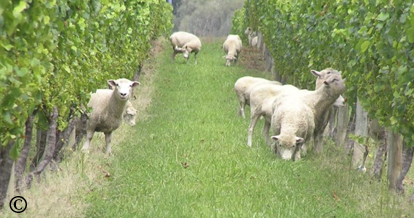 A guide to using sheep for leaf-plucking in the vineyard
A guide to using sheep for leaf-plucking in the vineyard
by Hawke's Bay Winegrowers Inc.
Why use sheep for leaf-plucking?
As a country, New Zealand has long been associated with sheep. Despite a drop in national flock numbers, sheep are still widely farmed for their meat and wool production. Luckily for winegrowers, sheep have a taste for vegetation other than grass. They will readily eat grapevine leaves (and fruit if ripe enough) which means we can utilise them in the vineyard.
Using sheep for leaf-plucking is becoming an increasingly common practice in Hawke’s Bay. This booklet aims to share some of this local knowledge, along with some important things to consider before using sheep for leaf-plucking. This includes:
| • |
Why use sheep for leaf plucking?
|
| • |
The basics
|
| • |
Spray and chemical use
|
| • |
Animal welfare
|
| • |
Grower experiences
|
| • |
Advice from graziers
|
| • |
Cost comparisons
|
| • |
Permanent flocks
|
| • |
Sources of further information
|
So what are the advantages?
Cost savings
Machine and hand leaf plucking can be expensive. In many cases, the cost of using sheep for leaf plucking only involves the transport of the animals to and from the property. So if you are using sheep on several blocks on the same property this can be a cost effective alternative to machinery and labour.
Fuel savings
Sheep can save on fuel compared to machine leaf plucking. Large leaf plucking machinery uses around 20L of diesel per hour, while the only fuel used for sheep leaf plucking is in the transport of the animals to and from the property.
Quality of the job
Many winegrowers believe that sheep do a better leaf plucking job than machines or people. Observations are that they are gentler and also seem to remove more internal leaves, which opens the canopy up to increase airflow and reduce disease pressure. While there have been no scientific trials, there is plenty of anecdotal evidence to support these observations.
Read More »
GRAZING VINEYARDS
Holistic approach to vineyard grazing
By Kelly Mulville
Grape farming can be simultaneously more profitable, ecologically resilient and socially responsible than the status quo of both conventional and sustainable practices. Through the synergy of human creativity, ecological principles and holistically sound decision making, viticultural practices can be weaned of the majority of off farm inputs and operate primarily by current solar income.
Spiraling increases in fuel, equipment, labor and fertilizer costs, along with the associated negative impacts to our environment by many of these practices make it imperative for us to find innovative and viable solutions for sustaining agriculture.
Advancing the economic viability and ecological integrity of viticulture will increasingly necessitate the presence and impact of properly managed grazing animals during the growing season of both the cover crop and the vines themselves. Proven stratigies exist to allow grazing throughout the year in many established vineyards and effective solutions have evolved for designing new vineyards conducive to holistically-based management.
The Synergy of Sheep
Results from a 2009 trial conducted in the Alexander Valley demonstrate that managed grazing of sheep in a vineyard through winter, spring and early summer can lead to the following benefits:
| • |
80%-90% reduction in irrigation use
|
| • |
Eliminates the need to mow or cultivate under vines and between rows due to the grazing activity of sheep which converts this plant material into fertilizer
|
| • |
Eliminates the need for hand suckering due to sheep browsing of this growth and converting it into fertilizer
|
| • |
Sheep can consume all canopy thinnings (laterals and leaves) placed on the ground and convert those into manure
|
| • |
Improves both yield and quality of fruit
|
| • |
Reduces reliance on and cost of machinery, fuels, fertilizers, hand labor and herbicides
|
| • |
Improves soils ability to sequester carbon
|
| • |
Reduces atmospheric carbon emissions
|
SHEEP INDUSTRY NEWS
Lamb and Wine - Not Just a Good Pair on the Dinner Table
By Becky Talley
Sheep Industry News Associate Editor (November 1, 2007)
It’s a classic pairing – lamb and wine. A good vintage served with a succulent lamb dish has graced the dining tables of many a home and fine dining establishment over the years.
However, wine is not just a favorite drink when served with lamb. Sometimes wine is a favorite dish for the lambs themselves, or the grapes and grape leaves are, at least.
When one thinks of prescribed grazing with sheep, non-native invasive species management on ranges and pastures comes to mind. However, in wine-producing regions, using sheep to graze vineyards is becoming a more popular option, especially among vineyards that are going to a more biodynamic or organic productions system.
Unfortunately, sheep are not much more selective about what they eat in a vineyard than they are in a pasture. If it’s there, they will eat it. For vineyards, this means leaves from the vine and even the grapes themselves, resulting in a major financial loss.
Enter a research team from University of California, Davis (UC Davis) that set out to find a way to discourage sheep from eating the profits and to encourage more producers and vineyards to use sheep for resource management in vineyards.
According to Morgan Doran, livestock and natural resources advisor for Napa, Solano, Yolo and Sacramento Counties and leader of the research team, sheep are generally brought into smaller vineyards that are trying to control weeds and cover crops, such as prickly lettuce, without the use of chemicals and are looking to incorporate more holistic management practices. In addition, weather conditions, such as a wet spring, can limit the use of tractors to mow or spray in the vines, whereas sheep can easily handle these conditions and do the work.
To keep sheep from eating the grapes or stunting the growth of the vines by eating leaves and new shoots, they have been most often used to graze during dormant periods in the winter, in the summer before fruit turned sweet or in the fall after harvest.
|
|